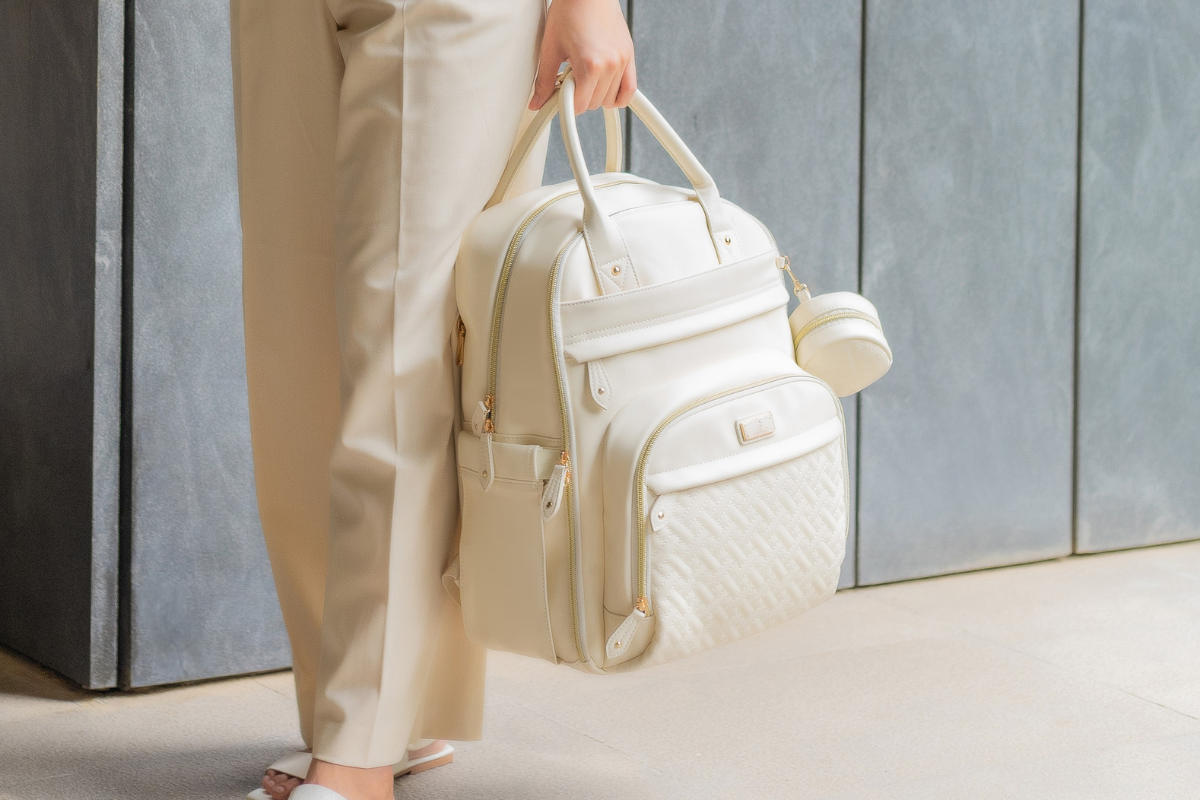As a mom, you’re probably looking for more ways to multitask — you’re juggling both your baby and your to-do lists all the time, and you’re wishing for a way to stay hands-free while keeping your little one close.
Luckily, there’s a solution just for that: A baby wrap carrier. It’s one of the best ways to bond with your baby and ensure their comfort while you go about your day.
Whether you're a first-time mom or looking to switch from other carriers, here’s why you should get a baby wrap carrier for you and your baby.
What are the different types of baby wrap carriers?
There are two different types of baby wrap carriers:
- Stretchy wraps: Made from a soft, stretchy fabric, these are great for newborns. They snugly hold your baby, but as they grow heavier, the wrap may lose some support. Our BabbleRoo baby wrap carrier is made with a breathable and stretchable fabric that ensures your baby doesn’t overheat and remains comfy in their cocoon.
- Woven wraps: These offer more support and are great for heavier babies or toddlers. They come in a variety of fabric types and can be used for various carrying positions.
Why should I use a baby wrap carrier?
There are many different benefits of using a baby wrap carrier for moms and their babies:
- Hands-free convenience: Whether you’re shopping or working from home, a baby carrier for moms allows you to be mobile while keeping your baby secure. Our BabbleRoo carrier wrap also includes a front pocket and two side pockets to store baby wipes, a burp cloth, a diaper, or a pacifier.
- Soothes your baby: The gentle rocking motion and the closeness of babywearing can help calm fussy babies, making it a lifesaver during naptimes or sleepless nights.
- Promotes physical and emotional development: Babies in a carrier for newborns tend to cry less and interact with their environment more. This promotes physical and cognitive development.
- Boosts your baby’s hip development: Our BabbleRoo baby carrier boosts hip development by positioning your baby in an M-shape. This ensures your baby’s legs and hips are supported as they develop in the first few months out of the womb.
- Comfort: A baby wrap carrier distributes your baby’s weight evenly throughout your shoulders, hips, and back, which makes it easier on your body during long carries.
- Bonding: Keeping your baby close fosters skin-to-skin connection which can soothe your baby and promote emotional bonding.
- Adjustable: Unlike structured carriers, wrap carriers can be adjusted for different body sizes, positions, and baby weights.
Also read: How A Baby Carrier Can Help New Moms and Dads
@theamandaensing Added bonus: wrapping makes it harder for random people to try & touch your baby 😉 #babywrap #babycarrier #momlife #newborn #babyhacks #newbornmusthaves #fyp ♬ original sound - AmandaEnsing
When should I start using a baby wrap carrier?
Generally, you can start using the baby wrap carrier soon after birth if your baby was born with no health complications and weigh around 8 lbs. Our BabbleRoo wrap carrier can hold up to 8 to 35 lbs (3.6-15.8 kgs).
For preterm, low-weight infants, and children with medical conditions, we recommend consulting a doctor first before wearing the carrier with your baby/toddler.
How long should I use the baby wrap carrier?
Our Babbleroo wrap carrier is suitable for newborns up to toddler age, but generally, most moms will use a baby wrap carrier for 6 months or more.
We do not recommend using it for more than 2 hours, but in case of extended use, check on your baby’s condition often and reposition them if needed. If your baby shows signs of distress or discomfort, take them out and stop using the carrier immediately.
Outside of general use, we don’t recommend using the baby carrier within 30 minutes of breastfeeding as it will press on your baby’s stomach and affect their digestion.
If your wrap carrier is showing signs of wear and tear (e.g. loose fabric or holes), stop using the carrier.
Where should I use the baby wrap carrier?
- At home: You can use the baby carrier at home to get things done while keeping your little one close. Whether you’re tidying up or reading a book on the couch, the wrap offers a chance to multitask.
- Outdoors: Going for a walk or running a few errands? A baby carrier is perfect for staying hands-free and ensuring your baby’s safe and comfy.
- Naptime: Many babies fall asleep while being carried. The wrap provides a cozy environment for naptime, allowing them to rest while staying close to you.
@aprilnlynch Replying to @Mattie B we love the @sollybaby in the newborn stage!! the link in my profile gives you 10% off too #babywearing #babywearingtutorial #babywearingmama #sollywrap #sollybabywrap #babywrap #babycarrier #postpartum #oneweekold #newbornessentials ♬ original sound - April Lynch
How do I put on the BabbleRoo baby wrap carrier?
Learning how to wrap your carrier around you and your baby can get overwhelming, but we’re here every step of the way. Here’s how you can put on our BabbleRoo baby wrap carrier:
#1: Put it on like a shirt
Put your BabbleRoo baby carrier on like you would when you’re wearing a shirt — loop your arms through the side holes of the carrier and then loop your head into the main hole.
#2: Adjust it like a shawl
Spread the front sashes over your shoulder and adjust them like you would when wearing a shawl. Make sure your sashes fully cover your shoulders.
#3: Pull down the back panel
Once you’ve adjusted your front sashes over your shoulders and chest, pull down the back panel as low as possible.
#4: Adjust the fit of your carrier
Adjust the fit of your baby wrap carrier by pulling on the straps. Your carrier shouldn’t be too tight or too loose.
How do I wear the BabbleRoo baby wrap carrier?
Before using BabbleRoo’s baby wrap carrier, practice putting it on a few times on the bed or a couch/sofa. Then, practice wearing the carrier a few times with your baby — if they start fussing or show any signs of discomfort, stop practicing and try again later.
If you and your baby are ready to try the carrier wrap, here’s how you can wear it:
#1: Carry your baby on your right chest
If your baby is facing inward, carry your baby gently on your right chest and hang their leg on the left shoulder sash. Carefully put your baby inside the space of the left sash of the carrier.
#2: Spread the sash over your baby
Spread the shoulder carrier wrap sash wide enough to cover your baby and repeat the process for the right sash with their left leg. Make sure to support your baby’s head throughout, and once your baby is secure in the carrier, pull both fabrics to cover your baby’s back and thighs.
Their legs and hips should be in an M-shape position which can be created by pulling the shoulder sashes down the bottom of your baby until the edges reach their knees.
#3: Readjust your fit
Finally, readjust the fit of your carrier by pulling on the straps. Always check all knots, buckles, snaps, straps, and any adjustments are secure.
Note: If you’re planning to put your baby in the wrap carrier facing inward from the bed, refer to our manual for the instructions.
#4: Put on the outer sash
The outer sash is an important part of the carrier for extra support and safety. To put it on, place it in the middle of your baby’s back. After that, cross the side sashes behind your back, bring them back to the front, and tie a secure knot in the center of the center of the outer sash.
#5: Insert the head support
The head support in our BabbleRoo wrap carrier is a removable pillow. To use it, insert the head support in the middle pocket of the outer sash.
While supporting the lower back of your baby’s head, carefully insert the head support inside the wrap carrier.
#6: Secure the head support
Cross the outer sashes at the back and tie a knot at the front to secure the wrap carrier’s head support.
If you’d like more help in putting on a baby wrap carrier, you can check our page here.
@ausher81818 The only way to get stuff done is by baby wearing! #babywearing #babycarrier #babywraptutorial #bobawrap #newbornmusthaves #babytips #babymusthaves #babyregistry #newmom #momtips #youngmom #momsunder30 #momlife #dayinmylife #wifey #dancewithturbotax #sahm #sahmlife #dayinmylife ♬ original sound - Anna Usher
Safety tips for babywearing with a wrap carrier
1. Follow the TICKS Rule for safe baby wearing
- Tight: Your wrap should be tight enough to hold your baby securely.
- In view at all times: Ensure your baby's face is visible.
- Close enough to kiss: You should be able to kiss your baby's head easily.
- Keep chin off chest: Your baby’s chin should never rest on their chest, as this can restrict breathing.
- Supported back: Ensure your baby’s back is straight and supported.
2. Check your baby’s hips
Make sure your baby’s legs are in the “M” position (knees higher than their hottom) to support healthy hip development and to prevent hip dysplasia.
3. Be aware of temperature
Baby wrap carriers are made of fabric, so it’s important to monitor your baby’s temperature, especially in hot weather. Make sure your baby isn’t overheating and dress them in weather-appropriate clothes. Don’t overdress your baby with too many layers.
You can also ensure your baby’s comfort by choosing a wrap carrier that’s made with a lighter and breathable fabric.
4. Ensure your baby’s nose and mouth are always visible
To prevent potential risks of suffocation or asphyxiation, make sure your baby’s mouth and nose are always visible and unobstructed. Their chin also shouldn’t be tucked close into their chest, and your baby should not slouch in their carrier. For this case, reposition your baby and take frequent breaks while wearing.
5. Ensure your vision is not obstructed
Be cautious and alert while carrying your baby in the wrap carrier. Always make sure your baby’s head does not block the wearer’s front view, and make sure your knots and buckles are secured.
Never use the baby carrier with a baby inside when balance or mobility is affected due to exercise, drowsiness, or medical conditions.
6. Avoid bending over and lying down
Leaning, bending over, or tripping can cause baby to fall. Keep one hand on baby while moving. If you want to bend over to pick up a fallen item, bend at your knees so your baby stays upright.
On a different note, if you want to lie down, take out your baby out of the carrier first and place them on a safe surface like the bed.
@wearmybaby BABYWEARING SAFETY 101 #parentingtips #babycarrier #babywearing #babywrap #newborn #pregnancy #newmama ♬ original sound - WearMyBaby
7. Avoid intense physical activities and driving
While light physical activity like walking is fine, don’t participate in intense physical activities like running, skiing, snowboarding etc. It’s unsafe for you and your baby.
Likewise, do not use the baby wrap carrier while driving or if you’re sitting in a passenger seat.
8. Avoid hot food and liquids
Be mindful of what you eat and drink while carrying your baby. While light snacks are okay, avoid taking hot and foods liquids (e.g. coffee, hot water, and soup) while your baby is in the carrier. Do not leave your baby near a fire or a heat source like a radiator at home.
9. Never use more than one baby in the carrier
The BabbleRoo baby carrier is designed to hold one baby at a time. Never hold two babies in one carrier wrap at the same time.
If you’re not using the carrier, store it away from your baby.
Practice makes perfect
If you're new to babywearing, don’t worry if it feels a bit tricky at first. With time, you’ll become more comfortable, and wrapping your baby will soon feel like second nature.
Featured diaper bag in featured image: BabbleRoo Dino Original Diaper Backpack



